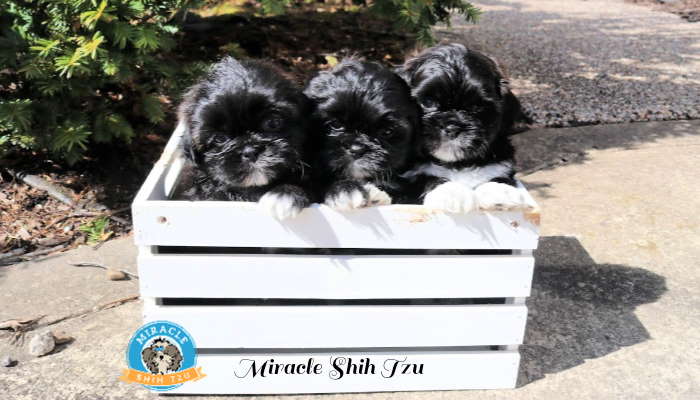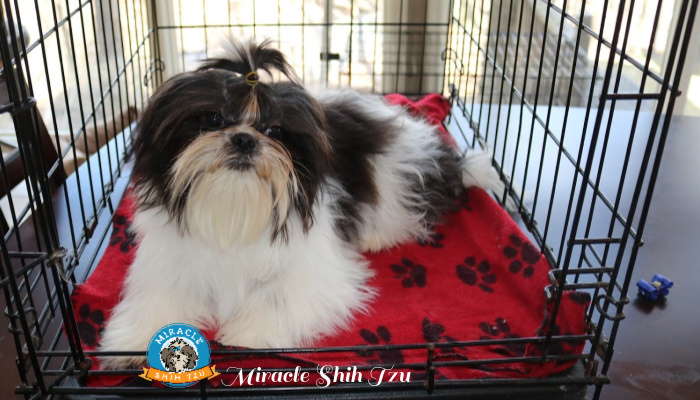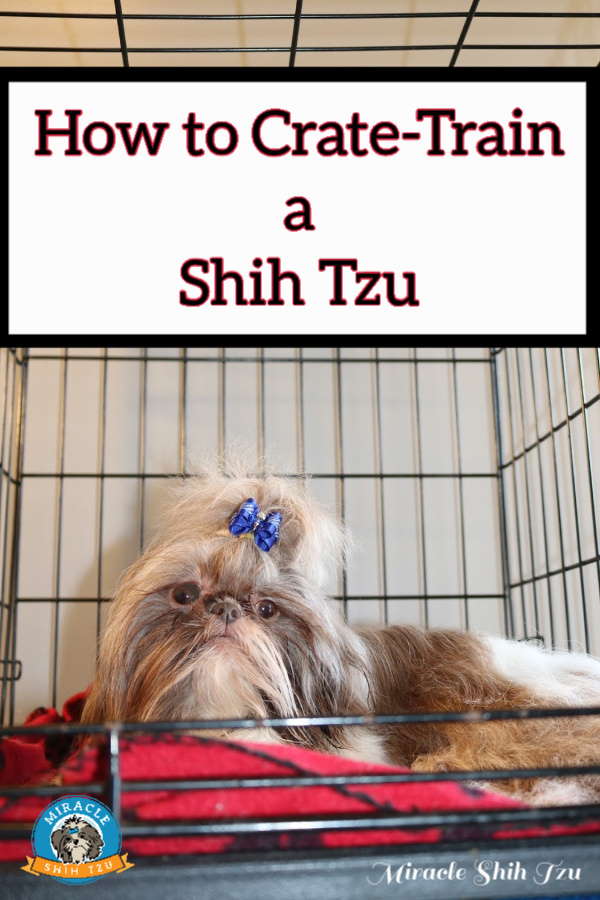How to Crate Train a Shih Tzu
Crate Train Shih Tzu by Stephanie N. Blahut |Updated 11-18-2022
Your sweet little dog may not look like a fierce wolf or a cunning fox. Like their wild relatives, though, dogs instinctively seek small, enclosed places in which to den. For many pups, that den is their crate. It is the place they feel the most secure as well as their retreat when they are in need of a little peace and quiet.
Yet, there are some people who consider crating to be cruel. They argue that dogs shouldn't be caged, especially for long periods. According to these pet lovers, crating is akin to a prison sentence for a dog.
Crate Train a Shih Tzu: Table of Contents
What's the Truth About Crating Your Shih Tzu?
Introducing Your Dog to the Crate
What's the Truth About Crating Your Shih Tzu?
The truth is that a crate can be a prison or a den, depending on the way it's used. In the hands of an irresponsible pet owner, a crate can become a jail cell. These owners will leave their pets in their enclosures for hours on end, without giving them time to exercise or a chance to relieve themselves. For an active canine or a dog that thrives on attention, such as a Shih Tzu, a crate can become the worst type of prison — solitary confinement.
In the hands of a responsible pet owner, a crate can be the safest place for a dog to be while home alone. Unsupervised dogs can get in all sorts of trouble when they're bored. They may, for example, decide to chew your shoes or gnaw on electrical cords, which could result in serious injury. Other canines will get into the trash and eat items they shouldn't. Crating is meant to protect your house from your dog, and your dog from itself.
Choosing a Crate Before You Try to Crate Train a Shih Tzu
 No, no, no, this is not what we mean by crate training!
No, no, no, this is not what we mean by crate training!A crate should be just big enough so that your dog can stand, sit, lay, turn and stretch. You don't want an enclosure that is much bigger than that because your pet may be tempted to urinate or defecate in the open area. If you are purchasing a crate for a puppy, look for one that has a sliding divider that will allow you to adjust the length of the living area as your pup grows. You can add a soft bed or blanket to make it more comfortable.
Crates come in all sizes and colors. A typical crate for an adult size Shih Tzu is normally 24 lenght x 18width x 19 height in inches and may include one or two doors.
Introducing Your Dog to the Crate
A rule of thumb is to put your dog in its crate when it is tired. That way, your dog will hopefully fall right to sleep, without putting up much of a protest. Avoid, if at all possible, putting your puppy in its crate right after playing with it. It will be all riled up and could become vocal about wanting to continue with its playtime.
If your puppy is reluctant to enter the crate, try luring him in with a tasty treat. Most puppies are curious and if they smell something tasty halfway into the crate, it is hard for them to resist the temptation to check it out.
Once in the crate, praise and give a little cuddle or scratch behind the ears to let the puppy know you are pleased with his actions.
You may need to practice these steps several times before you attempt to close the door.
Older dogs may respond to their crate with the anticipation that you will give them a small chew bone such as a dental treat.
Crate Train a Shih Tzu: Where Should You Place the Dog Crate?
 How to Crate Train a Shih Tzu
How to Crate Train a Shih TzuThere are two schools of thought about the placement of a puppy's crate. Some people prefer to keep their dog's enclosure in their bedroom, next to their bed. They believe that their puppy will be comforted by their presence and will, thus, be able to sleep better. In some cases, this works. However, pups may cry or scratch at their crates. This can make it hard for the human family members to get a good night's rest.
The other school of thought is to place the crate in a quiet room away from the family. This, of course, makes it easier for humans to get their beauty sleep. The downside is, it can be lonely for a pup. If you decide to go this route, make sure to give your dog something to comfort it.
Some owners, for example, will provide their furry family members with a hot water bottle wrapped in a towel, which is supposed to mimic the warmth of the puppy's mother. There are also stuffed dog toys on the market that have been designed specifically to comfort puppies. These products are soft and have pulsating heartbeats, just like a pup's former litter-mates and mom.
Remember, though that whatever method you choose, those first few nights in a new home maybe very hard on young puppies.
Note from Janice: Here's a great starter package from Amazon. You can also purchase the snuggle puppy alone and puppy buyers have told me it works wonders.
Don't Abuse the Crate
According to dog experts, puppies can generally hold their urine for one hour for every month of age. For example, a two-month-old puppy should be able to control its bladder for two hours. Older dogs can typically hold their urine for approximately four to six hours. If you will be at work for eight or more hours, consider hiring a dog walker to give your pup a chance to relieve itself during the middle of the day.
Also, avoid locking your dog in a crate while you're at home. Yes, there will be times when you'll want your dog out of your hair, but canines are pack animals. They crave being with their human pack members. This is especially true of dogs that were bred to be companion animals. For example, Shih Tzu were bred in China to be royal lap warmers for the emperor and his court. It's only natural that these dogs want to be by your side as much as possible.
Crate Train a Shih Tzu: Tips for Success: Dos and Don'ts
Do …
- Exercise and play with your dog before confining it to a crate
- Take it for a nice walk after letting it out of its crate
- Provide your pup with something safe to keep it entertained in its crate (see “That's Entertainment” below)
Do Not …
- Put your dog in a crate wearing its collars or tags. If these get caught on the bars or the doors of a crate, your pet could strangle itself
- Use the crate as punishment. You want your pet to think of its crate as a safe place, not somewhere it goes when it’s in trouble
Crate Train a Shih Tzu: That's Entertainment
If your dog will be spending a couple hours in a crate, make sure it has something to stay entertained. One of the best and safest items to leave in a crate is a rubber chew toy with a hollow center.
These can be stuffed with a variety of fillings — including kibble, peanut butter, plain yogurt and ground beef. Many owners will then freeze the rubber chew toy, so that their dogs will have to work harder to get at their tasty rewards. Puzzle toys that require a dog to maneuver them in order to get a tasty treat can also be a good source of entertainment.
Some items, however, should never be left in a dog's crate. These include:
- Tennis balls: Bigger dogs can destroy these relatively easily and may swallow the pieces. Some dogs will also gnaw the fuzz on a tennis ball, which could lead to an intestinal blockage.
- Nylon bones: If you read the packaging for these bones carefully, you will see that these bones are not meant to be eaten. Unfortunately, dogs with strong jaws can make quick work of these nylon bones. Luckily, Shih Tzu dogs are not known to have jaws of steel, so you may be able to get away with this one for this breed.
- Rope toys: Some dogs will swallow the strings from rope toys, which can cause gastrointestinal blockages.
Crate Train a Shih Tzu: The Takeaway
Crate training your dog may take a little work, so be patient. It can take at least six months before your canine is fully crate trained. In the end, it will be well worth the effort when you can leave your dog at home and know it will be happy and safe. Remember that like all training, crate training needs to be positive. Shih Tzu dogs are very sensitive to the mood of their owners and will pick up disapproval very quickly.
Remember the Dos and Don'ts (above).
Not all dogs take to the crate immediate. If yours does, consider yourself lucky. If not, don't despair and give up. All dogs can learn to love their crate with a little practice.
Crate Train a Shih Tzu: Author Bio
Stephanie N. Blahut is Director of Digital Marketing and Technology for Figo Pet Insurance. Figo is committed to helping pets and their families enjoy their lives together by fusing innovative technology — the first-of-its-kind Figo Pet Cloud — and the industry’s best pet insurance plans.
Crate Train a Shih Tzu: Pin for Future Reference
"Hi, I'm Janice Jones, a former veterinary technician and Shih Tzu expert with over 40 years of experience with the breed. Through Miracle Shih Tzu, I combine my medical background and extensive breed knowledge to provide reliable, practical advice for Shih Tzu owners. My mission is to help you give your Shih Tzu the happiest, healthiest life possible through evidence-based information and real-world solutions. Whether you're new to the breed or a seasoned owner, you'll find trusted guidance here for all aspects of Shih Tzu care.
I hold an undergraduate degree in Psychology with a minor in biology, Early Childhood Education, and Nursing, and a Master's in Mental Health Counseling.









